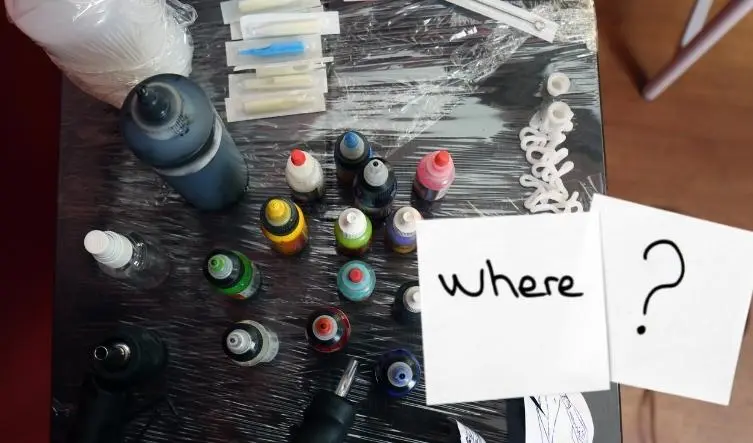When it comes to sublimation, there are many different opinions on the best way to go.
Many people seem to think that you can’t use pigment ink on sublimation paper, but is that true?
Let’s look at the pros and cons of using pigment ink on sublimation paper and help you decide what’s best for your business!
Can I Use Pigment Ink On Sublimation Paper?

The sublimation process turns the ink into a gas, which is actually fused into the fabric. Pigmented ink is not chemically capable of the same result and sits on top of the substrate. If you are looking for an ink that can be used for sublimation, you will need to find an ink specifically designed for this purpose.
How Sublimation Works?
It is important to understand how the sublimation process works to understand why pigment inks cannot be used for sublimation. The sublimation process begins with a digital design printed onto transfer paper using a special sublimation printer and inks. Then, the transfer paper is placed on top of the product the design is being transferred onto. Once the design has been aligned correctly, the transfer paper and product are placed into a heat press.
The temperature and pressure settings must be carefully adjusted according to the product used. The heat press activates the dye on the transfer paper, turning it into a gas. As the dye turns into a gas, it binds to the polymers on the product, permanently fusing itself between the fibers. Once the design has been transferred, it will not fade, crack, peel, or wash away like other printing methods.
Why You Can’t Use Pigment Ink?
Pigment inks are not reactive and, therefore, cannot be used in the sublimation process. Sublimation ‘ink’ is not really an ink – it is a dye designed to react with a coated substrate when heated. Normal ink does not transfer to a gas stage when heated onto the substrate, so most experts think it’s impossible to use pigment ink for sublimation.
If you want to use sublimation to transfer your designs onto products, you will need to use an ink specifically designed for this purpose. Pigment inks cannot be used for sublimation because they are not reactive and do not turn into a gas when heated. Sublimation inks are designed to react with a coated substrate when heated so that your designs can be transferred onto your products permanently.
Sublimation Ink Vs. Pigment Ink

Regarding sublimation ink vs. pigment ink, there are key differences to keep in mind.
For one, sublimation ink is a dye-based ink that is transferred onto a substrate via heat. This makes it ideal for use with polyester fabrics or other materials that can withstand high temperatures.
On the other hand, pigment ink is a dry powder that is applied to the substrate via an electrostatic charge. This makes it ideal for use with papers and other absorbent materials.
Regarding print quality, sublimation ink typically produces brighter and more vibrant colors than pigment ink. However, pigment ink is more resistant to fading and has a longer lifespan. Ultimately, your best choice will depend on your specific needs and requirements.
Where To Use Pigment Ink?

Pigment ink is a type of ink that is made from tiny pigment particles suspended in a liquid. Unlike dye-based inks, which rely on molecules of color to produce an image, pigment inks actually use particles of color.
This gives pigment inks several advantages over dye-based inks, including better fade resistance and greater durability. However, pigment inks are also more expensive than their dye-based counterparts and typically have a shorter lifespan.
As a result, they are not well suited for all applications. Pigment inks are most commonly used in printing applications where long-term durability is required, such as photographs and graphic design prints. They are also frequently used in archival printing, where the printed image mustn’t fade over time.
Can you use pigment ink on glossy paper?

Pigment ink is a type of ink made from ground-up pigments suspended in a liquid. It is commonly used in printers and photocopiers because it is less likely to fade over time than dye-based inks.
Pigment ink can be used on glossy paper, but it may not produce the same image quality as it would on matte paper. This is because the ink tends to sit on top of the paper rather than being absorbed, which can result in smudging or bleeding.
In addition, pigment inks are not as transparent as dye-based inks, so they may not show up as well on glossy paper. However, pigment ink may be the best option if you are looking for a more durable print.
So, while pigment ink can technically be used on sublimation paper, it is not generally recommended. If you want the best results possible with your sublimation printing, using a sublimation-specific ink will give you the most consistent and highest-quality prints. Talk to an expert at your local print shop to find out which inks they recommend for use with sublimation printers – and don’t forget to ask about papers too!
FAQ

What is pigment ink best for?
Pigment ink is most commonly used for archival printing, as it is fade resistant and has excellent color stability. Pigment inks are also good for photo printing, providing high-quality results with vivid colors. However, pigment inks are not used for production printing, as they are more expensive than other types of ink and dry more slowly.
Can you sublimate with pigment ink?
Pigment-based inks can be used for sublimation, but they are not as effective as dye-based inks. This is because pigment inks do not vaporize at the same temperatures as dye-based inks, limiting the range of materials used for sublimation.
Can pigment ink be used on paper?
Yes, you can. Pigment ink is a water-resistant, fade-resistant type of ink that is ideal for use on paper. It is available in a wide range of colors and can be used to create photo-realistic and more artistic images.
Conclusion: Pigment Ink On Sublimation Paper
Pigment Ink On Sublimation Paper. In conclusion, experimenting with pigment ink on sublimation paper introduces intriguing possibilities for print customization and versatility. While this unconventional approach may offer unique color profiles and enhanced durability, it also presents challenges in achieving the vibrant, gas-infused results characteristic of traditional sublimation inks. Understanding the balance between innovation and limitations can empower creators to explore new avenues in printing, while acknowledging the trade-offs inherent in using pigment ink on sublimation paper.
Watch: Pigment vs dye sublimation same heat transfer
Read more:
Regular Ink On Sublimation Paper: Is It Possible?
How to use parchment paper for sublimation?




